April 2025
April 2025 started and finished with some of the best April weather that I can remember in this area! The entire first half of the month saw high pressure dominate, meaning calm, dry, sunny weather with, admittedly, chilly mornings, but with constant blue skies, and warmer temperatures later in the day, it was pretty much perfect for wildlife-watching! Week 3 was a little more changeable, but still pretty decent, with , unusually, no last really wintry blast, and we even had a mini-heatwave as a finale!
Overall it was definitely warmer than average for April, with the mountain tops already losing most of their snow, and the leaves, flowers and insects definitely appearing a little earlier than usual, with the scenery now definitely having a springtime feel, and this encouraged a few of the summer visiting birds to arrive a little earlier than normal.
The days really are lengthening nicely now though, with around 14 hours of usable daylight, but dawn (for the Black Grouse lek) is now a slightly less sociable 5:30 am, so if this species is on your 'wish-list', be prepared for an early start...
Although many of the winter visiting birds had departed by mid-month, the ever increasing influx of summer migrant birds north into this area helped bird species day-lists creep ever higher, and 50+ species would not be uncommon on a full day local safari, or considerably more if you include a visit to the nearby Moray coast, whilst full day mammal species day-lists can creep up towards double figures, with early starts usually providing best results for the shyer ones.
The dawn chorus is at it's best in April, and it is always great to have your early start rewarded by getting to enjoy hearing the resident birds being joined by the newly arrived migrants like Willow Warbler, Chiffchaff, Blackcap and Tree Pipit.
Add to this the first brave butterflies and bees on the wing, the explosion (eventually) of spring flowers into full bloom and frogs and toads on the move, and the feelgood factor of this time of year is hard to beat...
I always think that wintertime and springtime give some of the best opportunities for scenic landscape photography in this area, and I felt very priviledged to enjoy some beautiful vistas again this month, so I have scattered a few of my photos around this report...
 |
| Springtime in the Cairngorms National Park |
To give you an idea of what you may realistically hope to see if you are considering a future April visit, I hope the following more detailed information, illustrated with photos taken at sites in and around the Cairngorms National Park, and sometimes further afield, by myself, my friends or my safari clients this month and in previous April's will help....clicking on the picture enlarges it to full-screen.
All photographs of wildlife, especially Schedule 1 and other protected or vulnerable bird species shown on this website were taken legally at long range with powerful zoom lenses, or from my vehicle on public roads, well away from nest sites, and no disturbance was caused to any wildlife..
Local speciality/upland bird species seen regularly during the month included:
Black Grouse (at, or soon after dawn only), Osprey, Red Grouse, Ring Ouzel, Slavonian Grebe, Red-Throated Diver, Black-Throated Diver, Goosander and Dipper, with a couple of decent sightings of Golden Eagle and White-Tailed Eagle early in the month... and just a few brief glimpses of Crested Tit and Crossbill......
Snow Buntings were seen at low level sites (2'000ft) early in the month, and after a fresh fall of snow, but seemed to retreat high up to the mountain tops, when the snow line receded...where Ptarmigan can also sometimes be seen...
Winter visiting birds were represented early in the month by a few remaining family groups of Whooper Swans, flocks of Greylag and Pink-Footed Geese, wildfowl such as Wigeon and Teal, and a few lingering Bramblings, Redwings and Fieldfares , but most had departed by mid-month...
Summer migrant birds flooded in throughout the month, with the first sightings this year of Osprey, Wheatear, Common Sandpiper, Sand Martin, House Martin, Swallow, Willow Warbler, Chiffchaff, Blackcap, Tree Pipit, Redstart and Cuckoo, to name just a few...
A good variety of seabirds, waders, wildfowl , Divers and Geese can be enjoyed at the Moray Coast and the nearby inland lochs...
Mammal species seen regularly included:
Red Deer, Roe Deer, Rabbit, Brown Hare, Red Squirrel, and Feral Mountain Goat, whilst Mountain Hare became much trickier as they morphed into their spring coat..and both types of Seal were seen at the nearby Moray coast...
April 2025 bird sightings in more detail:
On the lochs..
 |
| Early spring at a local freshwater loch |
One of my most eagerly-awaited wildlife moments every year, is the return of our local Ospreys to their nesting sites, and these impressive birds of prey are always popular with my safari clients, with their dashing good looks, large size, aerial acrobatics and spectacular plunge diving to catch fish. Many of our local pairs were reunited by mid-month after a winter apart in West Africa, and were soon seen building up their nests with sticks, chasing off intruders and mating frequently, and by the very end of the month some of the hen birds appeared to be incubating eggs as the cock birds began to perform all of the fishing duties, whilst the females presumably carried out brooding duties.
 |
| A pair of Ospreys atop their impressive nest |
 |
| Osprey |
 |
| Osprey with fish - Photo from April 2015 |
 |
| Osprey |
Now the local lochs are (finally) no longer in danger of freezing over, some of our highly prized local speciality water birds are back on their summer breeding territories, and we managed to see some of the most attractive and rare examples regularly this month - namely Slavonian (Horned) Grebe, Red-Throated Diver and Black-Throated Diver, all in their splendid summer plumage.
 |
| Slavonian (Horned) Grebes |
 |
| Slavonian (Horned) Grebe |
 |
| Red Throated Diver |
 |
| Red Throated Divers |
 |
| Black Throated Divers |
.JPG) |
| Black Throated Diver by Steve Nicklin |
Also on the lochs (and rivers), we must not forget our breeding Goldeneye population , and we were fortunate enough to see them regularly this month, with many of the dapper males still performing their unique and spectacular 'head-banging' mating display!
 |
| Goldeneyes |
The edges of the lochs can be good for seeing wader species such as Common Sandpiper and Redshank, and we also saw a less common wader in the form of a Greenshank, on the 24th....
 |
| Redshank |
 |
| Common Sandpiper |
Up on the moors....
 |
| A local heather moorland |
April is definitely THE month to see Black Grouse, and dawn (now around 5:30am) visits to local Black Grouse leks usually delight and amaze my safari clients with as many as 7 blue-black cock birds seen 'performing' in spectacularly aggressive fashion, their incredible bubbling and whooshing sounds drifting across the moor, and late in the month, we are sometimes lucky to witness the hen birds walking among them, watching the action, and presumably 'rating' the contestants, only around 20% of whom will 'get lucky', and previously we have even been lucky enough to see them mating with their chosen partner - a truly fantastic wildlife spectacle and a great way to start the day!
 |
| Female Black Grouse or 'Greyhen' |
 |
| A female Black Grouse watching two rival males duelling for her affections |
 |
| A male Black Grouse, red eyebrows aglow, attempts to impress a female |
 |
| Lekking Black Grouse |
Please be aware that Black Grouse lek sites are very rare and precious and can easily be ruined by selfish behaviour, disturbance and encroachment - we have lost 2 previously well-established sites locally due to poor human behaviour in recent years - And I was shocked to arrive at one site at dawn in mid-month last year - where we view safely from several hundred metres away - to find a 'photographer' literally standing on the lekking area, having spooked the birds away!! Unbelievable!! I took photos of the 'intruder; and his vehicle, and reported the incident to the Police Wildlife Crime Officers, and they dealt with the culprit.... but this type of incident can easily ruin the lek, and can prevent breeding taking place , as the females only visit the lek for mating for a few days each spring.....so please bear this in mind and keep a sensible (and legal!) distance away....
Our local moorlands continued to echo with the characteristic cackling calls of the cock Red Grouse, many of whom were seen still actively displaying from raised positions, with red 'eyebrows' aglow, presumably 'guarding' their territory and nesting female, and from mid-month I saw very few hen birds, suggesting that many may already be incubating eggs.....
 |
| A male Red Grouse keeping watch over his territory |
 |
| Male Red Grouse |
 |
| A beautifully marked female Red Grouse |
 |
| Male Red Grouse by Steve Nicklin |
With more potential food available now, moorlands can also produce decent bird of prey sightings in spring and summer, and this month we managed to see - in order of size - Merlin, Kestrel, Sparrowhawk, Common Buzzard, Red Kite, and on the 23rd, a Golden Eagle.....
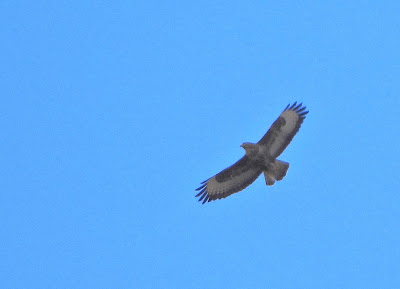 |
| Common Buzzard by Ian Dennis - Photo from April 2023 |
.JPG) |
| Female Merlin |
Up in the glens:
 |
| Early spring in a local U-shaped glacial valley |
Up in the local glens, it is worth noting that bird of prey sightings usually become less frequent during the longer days of spring and early summer, with many of the female birds nesting and many more hours of daylight available for hunting meaning that our chances are reduced. However, we still managed reasonably regular sightings of Osprey, Common Buzzard, Red Kite, Peregrine, Kestrel and Sparrowhawk, and also a few views of Goshawk, Golden Eagle and White-Tailed Eagle, and on the 8th, we finally got our first sighting of a Merlin this year...
 |
| Kestrel |
 |
| Common Buzzard |
 |
| Goshawk by Steve Nicklin - Photo from April 2019 |
 |
| Red Kite |
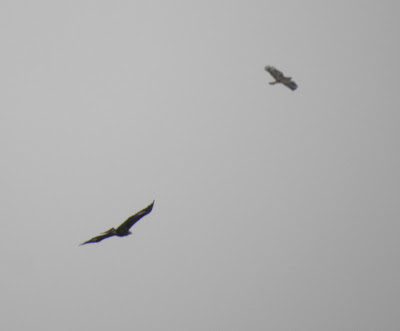 |
| Golden Eagle and Common Buzzard |
 |
| Golden Eagle - Photo from April 2022 |
 |
| White Tailed Eagle by Bob Smith - Photo from April 2021 |
 |
| White Tailed Eagle - Photo from April 2022 |
In the Caledonian pine forests...
 |
| A local Caledonian Pine Forest |
In the Caledonian forests, Crested Tit sightings became much more difficult to obtain this month, with one or two birds seen using forest feeding stations on the colder mornings, but generally they were pretty elusive, seemingly quietly going about their business breeding.....and I should point out that you really need to be familiar with their 'chuckling trill' of a song to have a realistic chance of seeing them... but I usually plan a short Caledonian forest walk in order to give us a chance...
 |
| Crested Tit |
 |
| Crested Tit - Photo from April 2023 |
It is well worth noting that the colder winter months (October-Feb) are actually the best time of year for seeing the 'wee Cresties', as these characterful little birds can be frustratingly secretive, unobtrusive and almost silent during the breeding season, with sightings being much more difficult to obtain between March and September....
Continuing the forest theme, unusually, we actually did ok for Crossbill sightings this month , though most of them were of the typical and rather annoying fly-over variety, we also had a few better views, and (unusually!) early in the month, we even managed a few photos, when birds perched obligingly for a few seconds!
 |
| Crossbill by Zayn Sargent |
 |
| Crossbill by Zayn Sargent |
Capercaillie
Please note that Capercaillie numbers would still appear to be alarmingly low, they are now very rare and elusive, possibly on the brink of extinction, and I would only rate our chances of seeing one on my safaris as "very slim" at best, and we are now requested not to go in search of them, for fear of disturbing them.....and please be aware that Police Scotland and the Cairngorms National Park Authority Rangers patrol 'known' Capercaillie areas for the first few hours of light throughout the spring/summer in an attempt to dissuade anyone from entering the forest and potentially disturbing the birds during lekking/breeding season.....with prosecution an option if you fail to heed their 'advice'....you have been warned....
https://cairngormscapercaillie.scot/lek-it-be/
On the marshes...
 |
| Early spring at Insh Marshes |
Although most of the winter visiting birds have now departed, a few lingering Whooper Swans and 'Grey' Geese could still be seen, and the numbers of waders such as Curlew, Oystercatcher, Redshank and Lapwing increased steadily throughout the month.....though raptors were seen less frequently than during the winter months with just the occasional sighting reported.....
.JPG) |
| Oystercatcher by Steve Nicklin |
On the rivers...
 |
| The River Spey |
It was noticeable that there were increased occurrences of male Dippers seemingly delivering food and additional nest material to the now well hidden female birds at their nest sites , usually underneath bridges or under high , overhanging banks...and we also witnessed a few instances of rival males having territorial disputes....
 |
| Dipper by Zayn Sargent |
 |
| Dipper with nesting material |
 |
| Dipper with food item |
We also saw Goosanders , Goldeneyes and Grey wagtails reasonably frequently on local rivers this month....and the first Common Sandpipers have now returned too......
 |
| Common Sandpiper |
 |
| Grey Wagtail |
 |
| Goosanders |
Up in the mountains....
.jpg) |
| The view from the summit of Cairngorm Mountain |
A walk up to the summit early in the month, sadly, failed to produce any sightings of Ptarmigan, despite much searching. Other birders were more fortunate though, with a few reported, but they are definitely less abundant these days....
 |
| Female Ptarmigan by Steve Nicklin - Photo from April 2018 |
 |
| Male Ptarmigan by Steve Nicklin - Photo from April 2018 |
Visits to the ski centre car park when the snow returned down to lower levels, gave us some decent views of a few lingering Snow Buntings, but they seemed to retreat high up to the mountain tops as the snow line receded....
 |
| Snow Buntings |
At slightly lower levels ( but still generally at 1,500ft/450m +) newly-arrived Ring Ouzels - sometimes called the Blackbird's mountain dwelling cousin - always prove to be popular with my safari clients, presumably because not many will have seen them locally, as they tend to breed only in remote upland areas well away from human disturbance, and can be quite tricky to find. We are fortunate in having plenty of suitable habitat for them in this area though, and we are often able to get decent views and sometimes photographs of newly-arrived male and female birds .....
 |
| Male Ring Ouzel |
 |
| Male Ring Ouzel |
On farmland...
 |
Typical local farmland
|
Wader numbers increased throughout the month, with Oystercatcher, Lapwing, Curlew and Golden Plover all noted, and a visible influx of passerine birds such as Meadow Pipit and Skylark , ready for breeding season...and a few lingering winter thrushes were also seen....alongside the resident Pheasants and Red Legged Partridges....
 |
| Red Legged Partridge |
 |
| Oystercatcher |
.JPG) |
| Curlew |
 |
| Lapwing |
 |
| Male Pheasant |
In local gardens:
 |
| My garden on the outskirts of Aviemore |
Although our garden is not quite as 'busy' as it was in the winter, as well as the expected selection of Thrushes, parrows, tits and finches, a few locals reported the odd Blackcap coming to their feeders....with the activity also attracting the attention of a Sparrowhawk on several occasions....
 |
| Song Thrush |
 |
| Male Siskin |
 |
| Greenfinch |
 |
| Female Bullfinch |
 |
| Male Sparrowhawk with prey |
A few photos of more common birds seen locally this month:
 |
| Greylag Geese |
 |
| Willow Warbler |
 |
| Meadow Pipit |
 |
| Male Bullfinch |
 |
| Male Stonechat |
 |
Jackdaw
|
 |
| Singing Song Thrush by Zayn Sargent |
Other good/scarce birds seen/reported locally this month included:
A Nuthatch near Laggan on the 3rd, 2 Shelduck at Lochindorb on the 13th, 2 Common Cranes near Dulnain Bridge on the 18th, a Green-Winged Teal at Uath Lochans on the 21st, a Whinchat at Drumguish on the 22nd, Grasshopper Warblers at Tulloch and at Kincraig on the 24th, and Greenshanks and Ringed Plovers at various sites throughout the month...,.
Adventures 'out of area':
The Moray coast is only about an hour drive north of Aviemore, and trips to favourite reserves, lochs, bays and harbours gave good views of lingering wintering birds such as Greylag Geese, Pink-Footed Geese, Whooper Swan, Shoveler, Wigeon, Teal, Pintail, Black-Tailed Godwit, Bar-Tailed Godwit, Knot, Golden Plover , Grey Plover , Ringed Plover, Purple Sandpiper, Redshank, Oystercatcher, Turnstone, Curlew, Common Scoter, Velvet Scoter, Long-Tailed Ducks, Eiders, Divers, and Slavonian Grebe, with the chance of rare/scarce birds such as American Wigeon, Green-Winged Teal, Tree Sparrow , Grey Partridge, and rare gulls.....
 |
| Wigeon |
 |
| Grey Plover by Steve Nicklin |
 |
Eiders
 | Male Red Breasted Merganser by Steve Nicklin
|
|
Whilst on and around our sea cliffs and stacks, nesting birds included: Fulmar, Kittiwake, Gannet, Common Guillemot, Razorbill, and we also saw a few of the less common Black Guillemots....
 |
| Gannets |
 |
| Black Guillemots |
 |
| Common Guillemots and Razorbills |
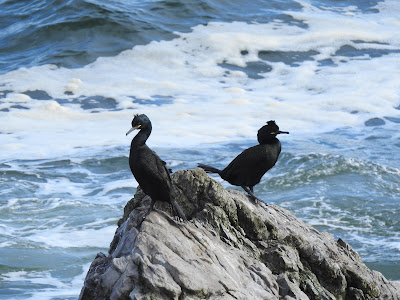 |
| Shags |
 |
| Razorbills by Steve Nicklin |
The freshwater lochs , nature reserves and farmland just inland from the Moray Coast can be productive too....
 |
Little Grebe
|
 |
| Male Goldeneye |
April 2025 mammal sightings in more detail:
Red Deer always prove popular with my safari clients. Being an iconic animal of the Scottish Highlands, the 'Monarch of the Glen' is on most visitors 'wish-lists', and we usually manage to see them regularly in large same-sex herds in upland glens this month, though views are usually quite distant. Many of the stags have now lost their old fully-grown antlers, and look a little less impressive while they are growing a new set...
 |
| Red Deer Stags |
 |
| Red Deer Stag |
Despite most of them now sporting their mottled white and blue-grey spring outfits, Mountain Hares usually seem to be the one to beat in our 'mammal of the day' awards in April - if we get to see them - far from guaranteed- as they certainly become tricky to find among the mottled white and blue-grey rocks of their upland homes!!
 |
| Mountain Hares |
It should be noted though, although we sometimes get lucky with a chance close encounter, that most of our views are at range through my telescope, and that a closer view or photographic opportunity usually involves some considerable amount of rough uphill walking, sometimes on snow, yes, even in April!
Feral Mountain Goats too are only found in a few remote upland areas of the UK, and we are sometimes fortunate enough to have good views of these wild looking, multi-coloured creatures, with the fast-growing youngsters now almost as big as the adults...
 |
| Feral Mountain Goats |
Seeing a Red Squirrel is always a treat, especially for those who don't have them locally - sadly, most UK residents - but we have good numbers here, and we were fortunate enough to see them regularly this month, sometimes at forest feeding stations, and sometimes running around or climbing trees...
 |
| Red Squirrel |
 |
| Red Squirrel |
Roe Deer however, are common and numerous over most of the UK, but due to their nervous nature and crepuscular habits, they are rarely seen well unless you are out and about early or late, or in a really quiet place, well away from human disturbance..
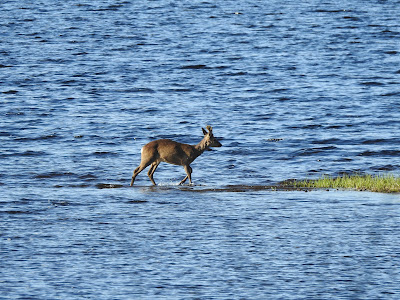 |
| Roe Deer |
As spring tends to arrive a little later this far north, where Brown Hares are concerned, we tend to get 'Mad April Hares' rather than 'Mad March Hares'' , and that proved to be the case this month, with lots of frisky behaviour being witnessed.
 |
| Brown Hare |
 |
| Brown Hares |
Hairy Highland Coo's always prove to be popular with my safari clients, especially those who do not have them close to home, so don't be afraid to ask me if you fancy going to see them, and maybe even get to feed and 'pat' them, as I have a couple of great sites....though sadly, lovely old Murdo, and his mate Buster the friendly Sheep, are now no longer with us, having both succumbed to old age and poor health late last year...
 |
| Hamish and Dougal |
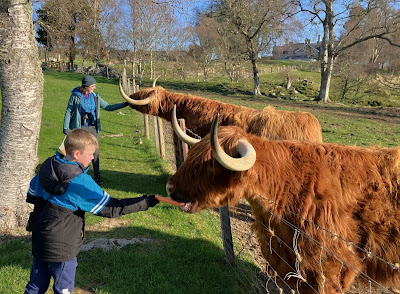 |
| Carrot time for Hamish and Dougal |
 |
| Carrot time for Dougal! |
Marine mammals:
The nearby Moray coast and Black isle are pretty reliable for sightings of Seals, with a decent chance of Harbour Porpoise and Dolphins, and,even a slim chance of Whales....
 |
| Bottlenose Dolphin seen at the Black Isle |
Rare/nocturnal mammals:
I get a few enquiries about the possibility of seeing Badgers and Pine Marten from my safari clients, many of whom I suspect are unaware that they are actually a largely nocturnal creature, and although we do get the occasional (maybe one or two a year) dawn glimpse of one, you would definitely have a much higher chance of seeing them at a specific dusk Badger/Pine Marten watching hide - Please contact me for more information.
Similarly, our inland Otters too are mainly active during the hours of darkness, and again, although we do get a few early-morning sightings on local lochs and rivers each year, looking for them feeding in a suitably quiet, kelp - filled bay on the coast on a rising tide, but at any time of day, would give you a much better chance.
Whilst we are still on the 'tricky to see stuff', the Scottish Wildcat too, as well as being incredibly rare now, is also generally nocturnal, and the fact that I have had a mere handful of (dawn or dusk) sightings in over 20 years of providing wildlife safaris should give you an idea of how difficult they are to see.
 |
| Spring Lamb with it's Mother |
Other wildlife:
Some of the warmer, sunnier days saw a few brave pioneering butterflies - Small Tortoiseshell, Peacock, Comma , Orange Tip and Small White - on the wing, joining the increasing numbers of bees, the first activity this year was noted in the Wood Ant colonies, and a few Bats were seen hawking insects over water at dusk.
Frogs and Toads too, were seen frequently.....
 |
| Common Toad |
News:
I am very pleased to announce that Highland Wildlife & Birdwatch Safaris has been awarded - for the third consecutive year - a Travelers Choice accreditation from Trip Advisor, for being ranked in the top 10% of visitor attractions worldwide, based on customer reviews and feedback.
This achievement would not have been possible without the support of all my family, friends, safari clients, social media followers, regular blog readers , the Visit Scotland 'mystery shoppers', and everyone else who has advised, helped and encouraged me along the way to ‘living my dream’ of being a wildlife safari guide, since 2004, especially over the last few very difficult COVID affected financial recovery years, so a big THANK YOU to you all :)
We have also upgraded our safari vehicle to a slightly newer Land Rover Discovery5 HSE LUX 7-seater, and this one has, along with excellent off-road and all-weather ability. 7 heated seats, and all the usual luxuries such as rear-seat entertainment DVD screens, a panoramic sunroof, and height-adjustable air suspension, and it is also more spacious and 'greener' than my previous versions with (ULEZ compliant) ultra-low emissions and improved fuel economy....
 |
| My new(er) safari vehicle on it's 'debut' outing in February 2024 |
All tourism/hospitality/activities in Scotland are open, are free of restrictions and I have now completed well over three years of (thankfully!) increasingly busy and extremely enjoyable safaris with clients with no major issues arising.
With all national travel restrictions lifted too, Scotland is officially 'open for business' for visitors from all over the UK, and from abroad.
For those considering a visit, these wildlife/outdoor tourism websites may prove useful:
June - September is midge season - But thankfully, this area is not usually affected too badly - This link explains why:
Bumper midge hatch alert after warm spell - BBC News
https://www.gov.scot/collections/coronavirus-covid
NatureScot (outdooraccess-scotland.scot)
Can Nature Help Health? | Nature Prescriptions - YouTube
Scotland, Yours to Enjoy. Responsibly. - YouTube
Cairngorms National Park Authority
Highland Wildlife Park
Positive prescriptions | The RSPB
www.scotlandbigpicture.com
 |
| The Pass of Ryvoan viewed from Cairngorm ski road |
COVID-19
The Scottish Highlands, being very sparsely populated, has had very few COVID-19 cases in comparison to most of the UK, and on my safaris we tend to visit remote , wild habitats well away from the more popular tourist areas, and usually have very little interaction with other people, and this is something that I intend to continue
 |
| April Daffodils |
Summary:
I apologise for repeating myself, as I seem to say this at this time every year, but It is only when I have time to sit down and compile my monthly wildlife sightings blog and look back through my notes and the photos that I and my safari clients have taken during the month that I really become aware of what a great time we have had, appreciate how lucky I am to live and work here, and see how successful our safaris have been.... and it would appear that aided by the very helpful good weather, April 2025 turned out to be a really excellent and very enjoyable month for wildlife watching in and around the Cairngorms National Park. With the returning summer visiting birds flooding northwards to join our local speciality resident species and a few lingering winter visiting birds, the dawn chorus, the days lengthening, flowers (finally!) blooming, the huge variety of unique and stunning scenery and the weather improving, I can honestly say that I would not want to be anywhere else in the world than here in the majestic Scottish Highlands at this time of year, and it was especially nice this month to be able to show it all off, and spend time with lots of my valued regulars, and also a number of new safari clients from all round the world, who were visiting this area for the first time.......happy days!!
 |
| A serene scene at a local upland loch |
Reviews:
I know a lot of visitors to this area very wisely check out reviews of attractions/experiences at TripAdvisor before 'taking the plunge' and making a booking - We now have over 360 reviews online, so if you wish, you can check out our clients comments at the link below....
https://www.tripadvisor.co.uk/Attraction_Review-g186537-d3335134-Reviews-
Highland_Wildlife_Birdwatch_Safaris-Aviemore_Aviemore_and_the_Cairngorms_Scottish.html
 |
| Sunrise on a local upland moor |
Gift Certificates:
 |
Safari gift voucher
|
If you think you know someone who may enjoy a taste of what I do, why not treat them to a safari gift certificate? They make a thoughtful and imaginative present, are available for any amount and are valid for a whole year from date of purchase........











.JPG)










.JPG)













.JPG)




.jpg)








.JPG)





























































